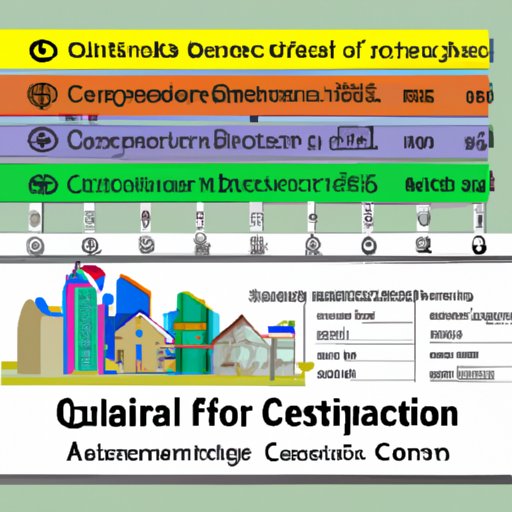Introduction
A certificate of occupancy is an official document that certifies a building is safe for human habitation or use. This document is issued by a local government agency after a building inspection. Obtaining a certificate of occupancy is essential for all commercial and residential buildings, as it confirms the property meets all applicable building codes and standards.
This article will explore the process of obtaining a certificate of occupancy, including outlining the necessary steps, understanding the timeline, navigating local building requirements, providing tips for speeding up the process, and exploring common challenges. By the end of this article, you will have a better understanding of the process needed to obtain a certificate of occupancy.

Outlining the Process: A Guide to Obtaining a Certificate of Occupancy
The first step in obtaining a certificate of occupancy is to identify local requirements. Every state and municipality has its own laws and regulations regarding certificates of occupancy. It is important to research local laws and contact local authorities to ensure you are compliant with all applicable regulations.
Once you have identified the local requirements, you must complete the necessary documentation. Depending on your location, this may include an application form, building plans, safety inspections, and other documents. It is important to carefully read all instructions and submit the correct paperwork.
Finally, you must submit your application to the appropriate local authority. After submitting the application, you should receive confirmation that your application has been received and is being processed.
Understanding the Timeline: How Long Does it Take to Get a Certificate of Occupancy?
The timeline for obtaining a certificate of occupancy varies depending on several factors. The size and complexity of the project, the local regulations, and the availability of inspectors can all affect the timeline. On average, it takes between four to six weeks to receive a certificate of occupancy.
It is important to note that the timeline may be shorter or longer depending on the circumstances. If the project is complex or there are delays in processing, it could take much longer than six weeks. Additionally, if the project is small and the paperwork is in order, it may be possible to receive the certificate sooner.

Navigating Local Building Requirements: The Necessary Steps for Obtaining a Certificate of Occupancy
Before a certificate of occupancy can be issued, a building must meet certain standards. These standards vary depending on the local regulations, but generally include fire safety, structural integrity, and land use regulations.
Fire safety standards require that a building is equipped with an adequate fire prevention system, such as smoke detectors and fire extinguishers. Structural integrity standards ensure that the building is structurally sound and free from any potential hazards. Finally, land use regulations ensure that the building is used in accordance with local zoning laws.

Tips for Speeding Up the Process: Strategies for Securing Your Certificate of Occupancy Quickly
There are several strategies you can employ to speed up the process of obtaining a certificate of occupancy. First, hiring an experienced professional can help ensure the paperwork is properly completed and submitted in a timely manner. An experienced professional can also provide valuable insight into local regulations and help you navigate the process.
Second, double-checking all documentation can help avoid any delays due to errors or omissions. Carefully review all forms and make sure they are filled out correctly before submitting them.
Finally, keeping track of progress can help ensure that the process moves forward quickly. Contact local authorities regularly to check on the status of your application and ensure that deadlines are met.
Exploring Common Challenges: Overcoming Roadblocks to Earning Your Certificate of Occupancy
Obtaining a certificate of occupancy can be a challenging process. Common challenges include problems with local authorities, delays in processing, and expensive fees. It is important to be prepared to address these issues if they arise.
If you encounter problems with local authorities, it is important to remain calm and polite. Try to understand their concerns and work with them to resolve the issue. Additionally, if you experience delays in processing, contact the local authorities to find out why and see if there is anything you can do to expedite the process.
Finally, some municipalities may charge expensive fees for certificates of occupancy. It is important to research local regulations to determine what fees may apply and budget accordingly.
Conclusion
In conclusion, obtaining a certificate of occupancy can be a lengthy process. It is important to understand the steps involved in the process, including identifying local requirements, completing necessary documentation, submitting an application, and navigating local building requirements. Additionally, it is important to understand the timeline and be aware of potential roadblocks, such as problems with local authorities, delays in processing, and expensive fees.
By following these guidelines and employing the strategies outlined in this article, you can successfully obtain a certificate of occupancy in a timely manner.
(Note: Is this article not meeting your expectations? Do you have knowledge or insights to share? Unlock new opportunities and expand your reach by joining our authors team. Click Registration to join us and share your expertise with our readers.)
